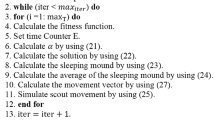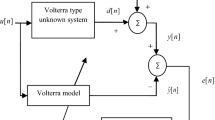Abstract
This paper proposes a performance assessment-based system identification of different practically useful open-loop and closed-loop Wiener systems using an evolutionary computational algorithm named as brain storm optimization (BSO) algorithm. Different performance measures of the estimation process in practical scenario, i.e., accuracy; precision; consistency; and computational time, are measured with a properly selected fitness function which is the output mean square error (MSE) between the desired and the estimated outputs. Bias and variance of the output MSE have been found negligible for each plant model to show the accuracy and consistency limits, and the corresponding statistical test results have been shown to establish the consistency of the BSO-based identification approach. Efficient identification of each plant under a noisy environment ensures the robustness and the stability of the proposed evolutionary-based identification approach with BSO. The BSO-based optimum MSE values, corresponding estimated parameter values, computational times and the other statistical information are all compared and are found to be superior to those of the other approaches reported earlier.































Similar content being viewed by others
References
A. Atitallah, S. Bedoui, K. Abderrahim, Identification of wiener time delay systems based on hierarchical gradient approach, in 8th Vienna International Conference on Mathematical Modelling MATHMOD 2015, vol. 48, no. 1 (2015), pp. 403–408
S. Billings, S. Fakhouri, Identification of systems containing linear dynamic and static nonlinear elements. Automatica 18, 15–26 (1982)
S. Boyd, I.O. Chua, Fading memory and the problem of approximating nonlinear operators with Volterra series. IEEE Trans. Circuits and Syst. 32(11), 1150–1161 (1985)
D. Dai, X.K. Ma, F.C. Li, Y. You, An approach for parameter estimation for a chaotic system based on genetic algorithm. Acta Phys. Sin. 51(11), 191–197 (2001)
B. Ding, X. Ping, Dynamic output feedback model predictive control for nonlinear systems represented by Hammerstein–Wiener model. J. Process Control 22(9), 1773–1784 (2012)
F. Ding, P.X. Liu, G. Liu, Gradient based and least squares based iterative identification methods for OE and OEMA systems. Digit. Signal Process. 20(5), 664–677 (2010)
F. Ding, T. Chen, Hierarchical gradient-based identification of multivariable discrete-time systems. Automatica 41(2), 315–325 (2005)
E.A. Elrady, L. Gan, Identification of Hammerstein and Wiener models using spectral magnitude matching, in Proceeding of the 17th World Congress on the International Federation of Automatic Control, Seoul, Korea, pp. 6440–6445, 6–11 July 2008
W. Greblicki, Non parametric approach to Wiener system identification. IEEE Trans. Circuit Syst. I 44(6), 538–545 (1997)
J.C. Gómez, A. Jutan, E. Baeyens, Wiener model identification and predictive control of a pH neutralisation process. IEE Proc. Control Theory Appl. 151(3), 329–338 (2004)
A. Hagenblad, L. Ljung, A. Wills, Maximum likelihood identification of Wiener models. Automatica 44(11), 2697–2705 (2008)
Q. He, L. wang, B. Liu, Parameter estimation for chaotic systems by particle swarm optimization. Chaos Solitons Fractals 34(2), 654–671 (2007)
I.W. Hunter, M.J. Korenburg, The identification of nonlinear biological systems: Wiener and Hammerstein cascade models. Biol. Cybern. 55(2–3), 135–144 (1986)
G. Kapetanios, A note on an iterative least-squares estimation method for ARMA and VARMA models. Econ. Lett. 79(3), 305–312 (2003)
K.K. Kima, E.R. Patrón, R.D. Braatz, Robust nonlinear internal model control of stable Wiener systems. J. Process Control 22(8), 1468–1477 (2012)
S.L. Lacy, D. Bernstein, Identification of FIR Wiener systems with unknown, non-invertible, polynomial non-linearities. Int. J. Control 76(15), 1500–1507 (2003)
S.L. Lacy, R.S. Erwin, D. Bernstein, Identification of Wiener systems with known noninvertible nonlinearities. J. Dyn. Syst. Meas. Control 123(4), 566–571 (2001)
E.K. Larsson, M. Mossberg, T. Söderstrom, An overview of important practical aspects of continuous-time ARMA system identification. Circuits Syst. Signal Process. 25(1), 17–46 (2006)
E.K. Larsson, E.G. Larsson, The Cramer-Rao bound for continuous-time AR parameter estimation with irregular sampling, in ICASSP 2001, Salt Lake City, Utah, USA, pp. 3097–3100 (2001)
C.J. Lin, Y.J. Xu, Design of neuro-fuzzy systems using a hybrid evolutionary learning algorithm. J. Inf. Sci. Eng. 23, 463–477 (2007)
Y.J. Liu, D.Q. Wang, F. Ding, Least-squares based iterative algorithms for identifying Box–Jenkins models with finite measurement data. Digit. Signal Process. 20(5), 1458–1467 (2010)
L. Ljung, Prediction error estimation methods. Circuits Syst. Signal Process. 21(1), 11–21 (2002)
M. Lovera, T. Gustafsson, M. Verhaegen, Recursive subspace identification of linear and non-linear Wiener state-space models. Automatica 36(11), 1639–1650 (2000)
J.C. Patra, W.C. Chin, P.K. Meher, G. Chakraborty, Development of the Laguerre neural-network-based intelligent sensors for wireless sensor networks. IEEE Trans. Instrum. Meas. 60(3), 725–734 (2011)
B. Peng, B. Liu, F.Y. Zhang, L. Wang, Differential evolution algorithm-based parameter estimation for chaotic systems. Chaos Solitons Fractals 39(5), 2110–2118 (2009)
Y. Shi, Brain Storm Optimization algorithm, in ICSI 2011, part I, China, pp. 18–27 (2011)
S. Tötterman, H.T. Toivonen, Support vector method for identification of Wiener models. J. Process Control 19(7), 1174–1181 (2009)
J. Vörös, Modeling and identification of nonlinear cascade and sandwich systems with general backlash. J. Electr. Eng. 65(2), 104–110 (2014)
J. Vörös, Identification of nonlinear dynamic systems with input saturation and output backlash using three-block cascaded models. J. Frankl. Inst. 351(12), 5455–5466 (2014)
R.J. Wai, Y.-F. Lin, K.-L. Chuang, Total-sliding-mode-based particle swarm optimization control for linear induction motor. J. Frankl. Inst. 351(5), 2755–2780 (2014)
R.E. Walpole, R.H. Myer, Probability and Statistics for Engineers and Scientists (Macmillan, New York, 1978)
Z. Wang, H. Gu, Parameter identification of bilinear system based on genetic algorithm, in Bio-Inspired computational intelligence and applications, vol. 4688, pp. 83–91 (2007)
D. Wang, F. Ding, Least squares based and gradient based iterative identification for Wiener nonlinear systems. Signal Process. 91(5), 1182–1189 (2011)
D.Q. Wang, G.W. Yang, R.F. ding, Gradient-based iterative parameter estimation for Box–Jenkins systems. Comput. Math. Appl. 60(5), 1200–1208 (2010)
J.S. Wang, Y.L. Hsu, Dynamic nonlinear system identification using a Wiener-type recurrent network with OKID algorithm. J. Inf. Sci. Eng. 24(3), 891–905 (2008)
D.T. Westwick, M. Verheagen, Identifying MIMO Wiener systems using subspace methods. Signal Process. 52(2), 235–258 (1996)
T. Wigren, Recursive prediction error identification using the nonlinear Wiener model. Automatica 29(4), 1011–1025 (1993)
Y. Zhao, D.T. Westwick, A direct approach to closed-loop identification of Wiener models using subspace-based methods, in Proceedings of ACC, Colorado, United States, pp. 3585–3589 (2003)
Y. Zhu, Distillation column identification of control using Wiener model. in Proceedings of American Control Conference vol. 5, pp. 3462–3466 (1999)
Author information
Authors and Affiliations
Corresponding author
Rights and permissions
About this article
Cite this article
Pal, P.S., Kar, R., Mandal, D. et al. Parametric Identification with Performance Assessment of Wiener Systems Using Brain Storm Optimization Algorithm. Circuits Syst Signal Process 36, 3143–3181 (2017). https://doi.org/10.1007/s00034-016-0464-7
Received:
Revised:
Accepted:
Published:
Issue Date:
DOI: https://doi.org/10.1007/s00034-016-0464-7




